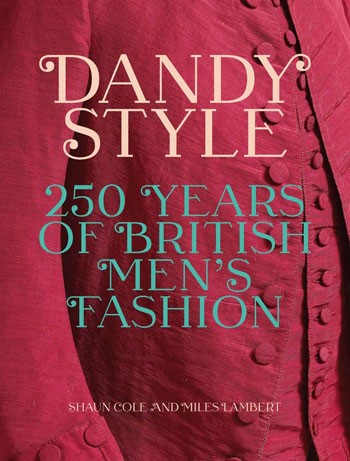|
DANDY STYLE : 250 YEARS OF BRITISH MEN’S FASHION
Manchester City Art Gallery 7th October 2022 to 1st
May 2023
Reviewed by Jim Burns
Coming from a time when dark colours were, on the whole, the
acknowledged pattern for men’s clothing, and not being a dedicated
follower of fashion, I won’t pretend that I’ve ever taken a great
deal of interest in what was in and what was out when it came to
what to wear. I perhaps made a gesture towards it when, as a young
bebop enthusiast in the early 1950s, I wore a drape suit in
imitation of the American musicians pictured in the
Melody Maker and
Jazz Journal. But the
army grabbed me in 1954 and when I came out in 1957 bohemianism was
very much in the air. I can’t say that I ever took to the modes of
dress associated with beatniks and the like. It seemed easier to
wear conventional trousers and jackets if I wanted to hold down jobs
and not be denied entry to pubs. I had the experience of being with
a couple I knew who did look like beatniks and seeing them refused
service while the landlord quite happily asked me what I would like
to drink.
These thoughts occurred to me as I wandered through the exhibition
in Manchester City Art Gallery. It essentially kicks off around the
time of Beau Brummell and his associates and demonstrates how their
way of wearing clothes was a reaction to the more-ornate and
colourful styles that had preceded them. The Macaronis with their
tall powdered-wigs and high-heeled shoes lent themselves to being
caricatured, and they were by Cruickshank and others. There is a
very fine book, Pretty
Gentlemen: Macaroni Men and the Eighteenth Century Fashion World
by Peter McNeil (Yale University Press, 2018), which explores the
activities of the Macaronis and shows them to be more complex, both
sartorially and socially, than a simple dismissal of social
privilege and affectation would imply.
The dandies could likewise be caricatured even if what they wore
seemed restrained in comparison to the Macaronis.
Looking at the enlarged
portrait of Brummell which adorns a wall in the gallery reminded me
that not everyone admired the dandies. There is a chapter in Ellen
Moers’ classic study, The
Dandy: Brummell to Beerbohm (Secker & Warburg, 1960) which
discusses the reaction from writers like Thackeray and Carlyle to
what the dandies represented. She says 1830 was the year “to
renounce the Regency and vilify the dandy class”. And she adds that
the growing “utilitarian middle-class” saw the dandy as “the epitome
of selfish irresponsibility…..the rising majority called for
equality, responsibility, energy; the dandy stood for superiority,
irresponsibility, inactivity”.
If a copy of the original can be found it’s worth looking at Bulwer
Lytton’s novel, Pelham or the
Adventures of a Gentleman, originally published in 1828 and
celebrated as “the hornbook of dandyism”, to see what caused Carlyle
to fulminate against it in his
Sartor Resartus.
In later
editions Bulwer, anxious to protect his reputation for sobriety in
the more strait-laced and morally-disapproving Victorian period,
edited out some of the descriptive passages about dandy idleness,
self-centredness, and concerns for the way one’s cravat was folded.
There were no doubt plenty of Victorians who nodded knowingly and
even approvingly when they heard that Brummell, after years of exile
in France, had died poverty-stricken, dirty, diseased and insane.
Moers goes on to say that “Distressingly personal in England, the
dandy ideal in France could become an abstraction, a refinement of
intellectual rebellion”. Writers like Baudelaire and Barbey
d’Aurevilly thought of the dandy in that way. And much later Albert
Camus included them in his book,
The Rebel: “The dandy is,
by occupation, always in opposition”.
Should anyone want to
read what Barbey
d’Aurevilly said about the dandy rebellion, a translation of his
essay is included in George Walden’s
Who is a Dandy? (Gibson
Square Books, 2002). Walden himself has useful things to say : “Yet
clothes, it can never be stressed enough, are merely the outward
sign of an inner disposition. True dandyism, aristocratic or
pseudo-proletarian, is a philosophy. This need not imply a highly
intellectual view of the world”.
By following a personal preoccupation with Brummell
I’ve drifted away from the exhibition. But it had its effect by
persuading me to get out some books and think about the dandies.
Walden’s book, referred to earlier, relates them to our own times
and current obsessions with celebrities, self, and how we look. The
excesses and refinements of male dress that became evident in the
1960s (in some cases almost back to the Macaronis) are on display in
Dandy Style. It’s an
informative exhibition, with paintings (Gainsborough, Thomas
Lawrence, Hockney) and photographs to accompany the clothes. Even if
the philosophical base for dandyism (if there is one) doesn’t
interest you it’s fascinating to see what men have chosen to wear
since Beau Brummell made his innovative alterations to how they
should dress.
|
